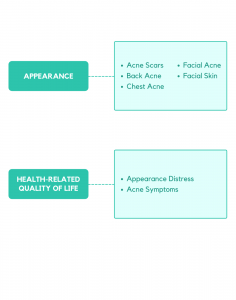Research
Field-tested in sample of 256 adolescents and adults with acne and acne scars.
The ACNE-Q was developed from 21 concept elicitation interviews with adolescents and adults with acne and acne scars, as well as input from 16 clinical experts from 5 countries. The ACNE-Q was then field-tested in a sample of 256 participants (aged >12 years) from Canada and the USA. In a 2022 systematic review of the measurement properties of 21 patient-reported outcome measures for acne vulgaris, the ACNE-Q was 1 of only 2 instruments recommended for use among patients with acne. In 2022, our team recruited an international sample of 595 people with acne from 3 countries using the online Prolific platform. Results from this study are forthcoming.

The ACNE-Q has 7 independently functioning scales that measure appearance (of facial, back and chest acne, skin and acne scars), acne-related symptoms and appearance-related distress. The variety of scales provides flexibility to choose the subset of scales best suited to measure the outcomes of interest in any given study or clinical situation.
Field-tested in sample of 256 adolescents and adults with acne and acne scars.
Used in international clinical trials of treatments for acne and acne scars.
Can be used to benchmark outcomes in quality improvement initiatives.
Designed using a modern psychometric approach to facilitate use in patient care.
ACNE-Q represents the first rigorously developed acne-specific patient-reported outcome measure to provide a set of scales for patients to report how their skin, acne (facial, back, and chest) and acne scars look. These concepts are important to include in clinical trials of treatments to improve or clear acne, to prevent and improve acne scarring, or to prevent future outbreaks. The ACNE-Q conceptual framework covers 3 concepts within 2 top-level domains. These concepts are measured via 7 independently functioning scales. Since its publication in 2019, ACNE-Q has been licensed in 10 countries. Clinicians and researchers are able to administer the subset of scales relevant to their situation.
Five scales measure how someone’s acne (face, chest and back), acne scars, and facial skin look. Example items ask about the amount of acne, how noticeable it is, and how the acne looks in photos, from the side, or under a bright light.
The ACNE-Q includes a short scale that measures how bothered someone is by acne-specific symptoms (e.g., itchy, hurts, feels uncomfortable).
In clinical trials of treatments for acne and acne scars, appearance-related distress is an important outcome. The ACNE-Q includes a scale that measures how often someone behaves (e.g., cover up, avoid going out) and feels (e.g., unhappy, self-conscious) a certain way about how they look.


